(Supply Creek, tributary to the Trinity River, tributary to the Klamath River)
Species / Location
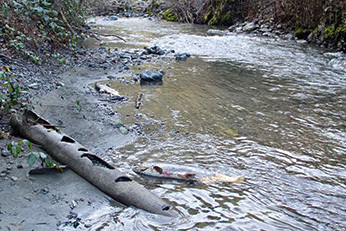 (Photo © Thomas Dunklin)
(Photo © Thomas Dunklin)
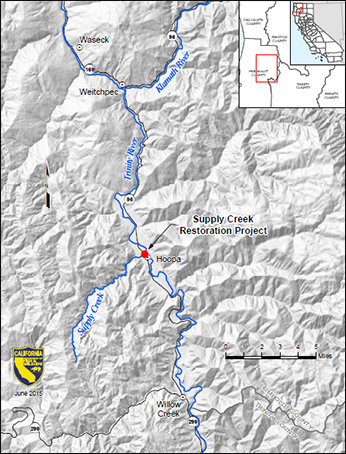 (click/tap to enlarge)
(click/tap to enlarge)
Supply Creek, located in Humboldt County, is a tributary to the Trinity River which is a tributary to the Klamath River, a major stream for the Southern Oregon Northern California Coast Evolutionarily Significant Unit (SONCC ESU) coho salmon and other anadromous fishes (see map). Coho salmon in the SONCC ESU were listed as threatened under the Federal Endangered Species Act in 1997, and formally listed as threatened under the California Endangered Species Act in 2005. Some major human stresses contributing to recent and historic population declines include loss or degradation of habitat caused by dams, water diversions, marijuana cultivation, poor logging practices, agricultural land development and overfishing. Natural stress factors may include floods and droughts, poor ocean conditions, disease, predation, wildfires and poor water quality.
Low gradient floodplain habitat and appropriately sized gravels favored by spawning coho salmon are rare in the tributaries to the Trinity River. Natal and non-natal rearing salmon and steelhead often seek cold water in these tributaries as the Trinity River becomes too warm, especially during periods of drought. Hoopa Valley Tribe biologists have observed and documented coho salmon juveniles in Supply Creek 10 out of the last 15 years. During the 2014 drought, both winter and summer flows were the lowest on record in Supply Creek, but the creek provided suitable flows and temperatures to support juvenile year round rearing.
Need for Project
During the 1964 flood, a massive torrent of sediment overwhelmed the Hoopa Valley floor, including lower Supply Creek. Flooding was significant, destroying riparian vegetation, structures and roadways. In the aftermath of the flood, the United States Army Corps of Engineers channelized the lower reach of Supply Creek. Channelization persists today and severely constrains salmon, steelhead trout and Pacific lamprey habitat, impairing the stream’s ability to provide critical over-winter habitat. Constructed levees keep the stream flowing fast and straight, transporting smaller gravels out of the reach. Thus, larger gravels remain which support only the largest spawning Chinook salmon (Figures 1 and 2). The confinement also limits riparian habitat and stream complexity.
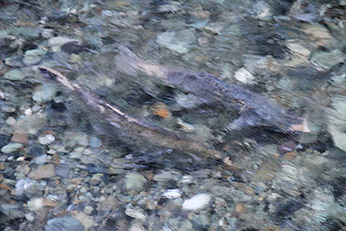 Figure 1 (Photo © Thomas Dunklin)
Figure 1 (Photo © Thomas Dunklin)
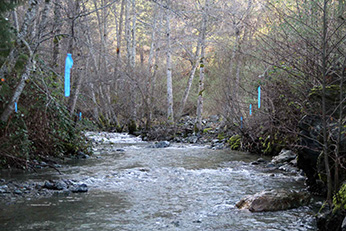 Figure 2 (Photo © Thomas Dunklin)
Figure 2 (Photo © Thomas Dunklin)
Project Benefits
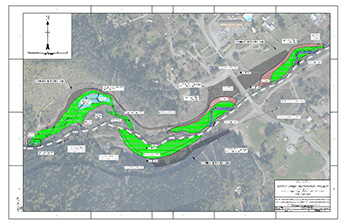 Figure 3 (click/tap to enlarge)
Figure 3 (click/tap to enlarge)
Salmon, steelhead trout and Pacific lamprey will benefit from the Supply Creek Restoration Project by providing immediate high quality winter and summer juvenile rearing habitat, and increasing the amount and quality of drought resilient habitat by breaching levees and constructing off-channel ponds, seasonal wetlands, floodplains, and side channel habitat. Click on Figure 3 below to view project outline.
Monitoring
Pre-project baseline monitoring will occur prior to implementation. Post-project monitoring will include physical monitoring to ensure the constructed channel meets the as-built criteria using longitudinal profile, cross-sectional, vegetation survival surveys, and photo monitoring. Hoopa Valley tribe will continue to monitor out-migrant juveniles and may use Passive Integrated Transponder ( PIT) technology to monitor movement of tagged fish within the restoration project area.
Partners
Project design and implementation is a collaborative effort with:
- California Department of Fish and Wildlife
- Hoopa Valley Tribe Fisheries Department
- Natural Resources Conservation Service
CDFW